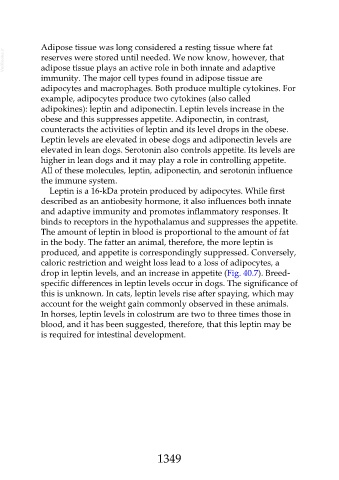Page 1349 - Veterinary Immunology, 10th Edition
P. 1349
Adipose tissue was long considered a resting tissue where fat
VetBooks.ir reserves were stored until needed. We now know, however, that
adipose tissue plays an active role in both innate and adaptive
immunity. The major cell types found in adipose tissue are
adipocytes and macrophages. Both produce multiple cytokines. For
example, adipocytes produce two cytokines (also called
adipokines): leptin and adiponectin. Leptin levels increase in the
obese and this suppresses appetite. Adiponectin, in contrast,
counteracts the activities of leptin and its level drops in the obese.
Leptin levels are elevated in obese dogs and adiponectin levels are
elevated in lean dogs. Serotonin also controls appetite. Its levels are
higher in lean dogs and it may play a role in controlling appetite.
All of these molecules, leptin, adiponectin, and serotonin influence
the immune system.
Leptin is a 16-kDa protein produced by adipocytes. While first
described as an antiobesity hormone, it also influences both innate
and adaptive immunity and promotes inflammatory responses. It
binds to receptors in the hypothalamus and suppresses the appetite.
The amount of leptin in blood is proportional to the amount of fat
in the body. The fatter an animal, therefore, the more leptin is
produced, and appetite is correspondingly suppressed. Conversely,
caloric restriction and weight loss lead to a loss of adipocytes, a
drop in leptin levels, and an increase in appetite (Fig. 40.7). Breed-
specific differences in leptin levels occur in dogs. The significance of
this is unknown. In cats, leptin levels rise after spaying, which may
account for the weight gain commonly observed in these animals.
In horses, leptin levels in colostrum are two to three times those in
blood, and it has been suggested, therefore, that this leptin may be
is required for intestinal development.
1349

